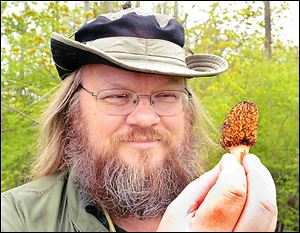
Morels tasty target for spring hunters
5/18/2013
Antoine Delaforterie holds a morel mushroom that he found in Rochester Hills, Mich.
These hunters slip into the forests and woods of Ohio and Michigan each spring, unarmed. They move about as discreetly as possible, and with a sense of purpose — heads down, eyes scanning back and forth as if they are looking for a lost coin or a piece of trace evidence.
But the subject of their concentrated search is an odd-looking life form, one of the estimated millions of species of fungi. These are the mushroom hunters, and morels are their target.
Morels are a spongy-looking mushroom whose heads are a honeycombed configuration of ridges and valleys, and whose stems are hollow. They are a highly-prized delicacy, and highly-sought after by gourmet cooks around the world.
The woodlands of the Midwest provide an excellent habitat for mushrooms, and thus are a great place for the hunters to canvass. The Maumee State Forest, which occupies some 3,000 acres in a patchwork of locations in Fulton, Henry, and Lucas counties, will play host to upward of a couple thousand mushroomers each spring.
“About 95 percent of the mushroom hunters we see are looking for morels,” said Don Schmenk, who manages the Maumee State Forest for the Ohio Department of Natural Resources.
Since a number of wild mushrooms are poisonous or deadly, the hunters dare not make a mistake in identifying their quarry.
“With morels, they have that particular look and characteristics that are distinct enough that most experienced mushroom hunters are confident in what they are seeing is safe,” Schmenk said. “When in doubt, you don’t want to eat it, that is for sure.”
Mushroom hunters have a saying that emphasizes the importance of properly identifying a wild mushroom before considering it for the table. “There are old mushroom hunters, and bold mushroom hunters, but there are no old, bold mushroom hunters,” the saying relates.
The color of morels varies, from yellow to gray to tints of black, but each has that distinct hollow stem. A false morel has a similar type head to the edible morel, but its stem is bulkier and not hollow. False morels contain a toxin that can cause serious illness or death. With some of the most dangerous wild mushrooms, the name essentially says it all. The Destroying Angel mushroom is an all-white variety that is common in Ohio, and potentially deadly if consumed.
The best companion for a beginner is an experienced mushroom hunter, while the best preparation for a fungi hunt is one of the mushroom hunter’s field guides with pictures of the many varieties found in the woods. While the object of their affection is undoubtedly the morel, it is good to know what all is out there.
The arrival of the prized morels each spring is much anticipated, but tough to pinpoint. Most experienced mushroom hunters believe that the first batch of morels will emerge after a few warm days followed by a moderate to heavy rain, but there are as many theories on the exact timing of the morels’ appearance as there are wild mushroom varieties.
“It’s weather-dependent, but they mysteriously come up,” Schmenk said. “The long-time mushroom hunters used to talk about Mother’s Day being the possible peak time for morels, but with the arrival of spring varying so much in recent years, it’s tough to say if that is really accurate. We could be toward the end of the morels, but if we get another shot of rain, we could have more coming out.”
Morels and other wild mushrooms will typically be found growing under or around the debris on the forest floor — leaves, dead wood, and other rich organic matter.
“You tend to find them in moister soils,” Schmenk said. “Out here in the Oak Openings area, the darker, sandier, moister soils tend to be better for mushroom hunting.”
Certain areas seem to be productive for morels year after year, so the mushroom hunters will protect their secret hunting grounds the same way anglers keep tight-lipped about their favorite fishing hole. Some veteran morel hunters will swear that abandoned orchards and sections of the woods with ash or elm trees are the most productive, but Schmenk cautions against limiting the search to such specifics.
“I would never rule out any spot in the woods, because people have been known to find them all over the place,” he said. “Although old trees that have died within the last two or three years are always good candidates to have mushrooms around, don’t rule out any area. I’ve found them in places you would never think they would be.”
Because morels spread by tiny spores, the wind can carry them to unexpected locations. “If that spore lands in an area with decaying organic matter, you could have morels appear there, if the right conditions are present.”
Part of the challenge of hunting for morels in the woods or the forest comes from the fact they usually blend in so well with the surroundings. The spongy heads will pop up in brushy cover, or among piles of leaves, meaning there are very little contrasting colors to make the morels stand out. After nearly tripping over one, a closer, more precise search of the area will often reveal a number of morels in close proximity.
Morels are such a popular delicacy, Michigan’s Boyne City has hosted a morel festival each May for more than half a century. The recipes offered at the festival cover the gamut from traditional to exotic, but the morel is always the star of the show.
Contact Blade outdoors editor Matt Markey at: mmarkey@theblade.com or 419-724-6068.